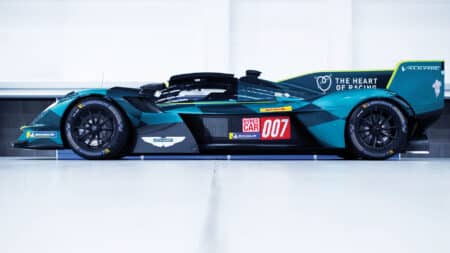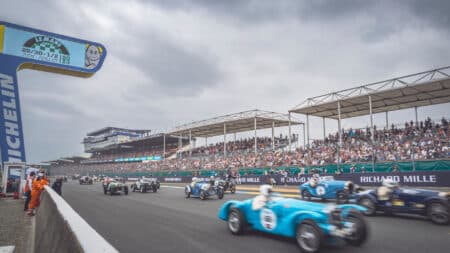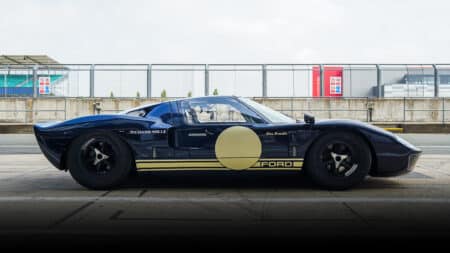
Aston Martin Valkyrie hypercar gallery: Racing's most beautiful car
Monstrous yet beautiful, the Aston Martin Valkyrie is fighting its way up the sports car field with a screaming V12 – here's our exclusive photoshoot with the car
The new Le Mans prototype regulations bear a resemblance to those proposed around 2006, but these ones are far more progressive, writes Gary Watkins
Cars with more than a hint of their road-going cousins, bigger cockpit dimensions and an end to aggressive front-end aerodynamics at the Le Mans 24 Hours. This sounds like the vision for prototypes in 2020, but it isn’t. But these were the ideas laid out by race organiser, the Automobile Club de l’Ouest, more than 10 years ago.
The ACO believed back in 2006-07 that it needed a coupé-only formula that allowed manufacturers to incorporate styling cues from their product ranges to encourage more car makers to compete. This was a time, remember, of limited manufacturer participation at the highest level at Le Mans.
That makes the proposals from all those years ago similar to the ideas that were laid out for the 2020/21 World Endurance Championship last month. But it would be wrong to suggest that the rule makers are looking to the past for inspiration. The new rules, outlined in draft form in the week of the Le Mans 24 Hours in June, are as innovative as they come.
The idea of pure-bred prototypes looking like road-going sportscars isn’t new. But many other of the principles of a rulebook that should be firmed up by the end of the year — or must be firmed up — are very much new and highly creative.
The proposed regulations solve the age-old problem of allowing machinery based on road cars, even if it is just the shape, to compete on something approaching equal terms. Think back to the mid-1990s, and the escalation of technology in the GT1 category. Toyota’s GT-One of 1998 was in a completely different league to the first iteration of the McLaren F1 GTR, little more than a souped-up road car, that had preceded it by only three years.
The idea is that aerodynamic targets will be laid down for the new breed of cars. Maximum downforce and minimum drag will be set and the manufacturers — or constructors because the new rules are destined to create a one-for-all class — will not be permitted to go beyond them. Full-scale wind tunnel testing and body-scanning of the cars will enable the strict limits to be effectively policed.
But here’s the really clever part: because the aero numbers will be more conservative than those the manufacturers have been able to achieve in the current big-buck era of twin-hybrid LMP1s, the category will be significantly cheaper. The massively-expensive wind tunnel and computational fluid dynamics programmes of today will be rendered a thing of the past. You won’t have to spend big money to achieve the numbers.
That makes the category more accessible for manufacturers that might have been frightened off by the seven-figure budgets being spent by the likes of Audi, Toyota and Porsche over the past few years, as well as the privateers who have just a fraction of that budget. And there’ll be no more of the messy Equivalence of Technology used in the 2018/19 WEC ‘superseason’ to create some kind of balance between the factories and the independents.
The rules governing aerodynamics will be combined with other regulations to reduce cost by as much as 75 per cent compared to present levels. The scope of the hybrid systems will be reduced. Just one system, a KERS on the front axle, will be allowed and those manufacturers or constructors not wishing to develop their own will be able to lease an off-the-peg system — battery and all — from one of the entrants that does.
The WEC is taking a leaf out of the book of Formula E. A rule in the FIA’s electric-vehicle series demands that manufacturers developing their own powertrains must make them available to other entrants at a reasonable price. It is a rule that is being exploited rather nicely this season by the Techeetah team, with its use of the Renault powertrain.
It would be wrong to draw too much of a comparison to the rules for Le Mans and its attendant series back in 2006-07. The rules that will come into force when the WEC season kicks off in the late summer or autumn of 2020 have only a few principles in common with those proposed back in 2006 and ’07. There was the belief, then as now, that opening up prototype racing to cars that look something like road cars would make the class more attractive to the manufacturers.
It didn’t turn out that way nearly a dozen years ago, even though there was some interest. When the ACO insisted that it was pressing ahead with its ideas at Le Mans in 2007, it revealed a rendering of an LMP car styled in the image of a Chevrolet Corvette.
The General Motors brand denied all knowledge of the image, and it appeared that it was an ACO creation. But it was based on a photograph of a wind tunnel model of an LMP ‘Vette that had been under development at Pratt & Miller, Chevrolet’s long-term motor sport partner.
Aston Martin showed interest, too. Out of that interest came its return to the prototype class. Prodrive-run Aston Martin Racing took a Lola P1 chassis and put the GT1 engine from the DBR9 in the back and ran it under the Charouz Racing System banner in 2008, before giving its own aero treatment to the Lola design and mounting a much more concerted campaign in 2009 and through in 2010.
The problem for the ACO was that Audi, the established king of Le Mans, and newcomer Peugeot, wasn’t in favour. And nor were many of the privateers, the likes of Pescarolo Sport and Zytek Engineering, who’d just built new cars for a new set of regulations.
The ‘Evo’ rules had to be abandoned. The idea of incorporating GT1 engines into the regulations with a small performance break was a kind of hangover from the idea.
And that’s another key difference with today. The manufacturers, or at least five or six of them, have been involved in the conception of the new rules. So, while it seems that the WEC is revisiting an old idea, this is a significant step forward.

Monstrous yet beautiful, the Aston Martin Valkyrie is fighting its way up the sports car field with a screaming V12 – here's our exclusive photoshoot with the car

It's the final day of racing at the 2025 Le Mans Classic. Watch the live stream here for coverage of the world's biggest historic race meeting

A final track test for Alex Brundle before heading to the 2025 Le Mans Classic: see how he fine-tunes the legendary Ford GT40 for La Sarthe, and hear how Jackie Oliver won the 1969 24-hour race in one of the cars

How to eke out maximum performance from the Ford GT40's V8 engine: join Alex Brundle as he prepares for the Le Mans Classic